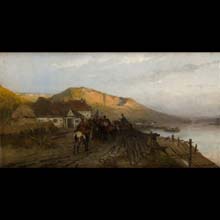
material: oil on canvas
dimensions: 34 × 65 cm
description: Józef Brandt was one of the greatest artists associated with the Polish community in Munich. Following the example of Juliusz Kossak, he took an interest in the customs of the gentry and the celebrated history of Poland. Both artists drew their inspiration from the Eastern Borderlands, visiting this region together in search of motifs for their works. The romantic, deeply emotional vision of the Borderlands presented in Brandt’s painting was often inspired by literature. His works, painted with bravura, depicted genre and battle scenes, fascinating his contemporaries with their oriental vividness and serving as a source of inspiration for other artists. Crossing the Dnieper River is one of Brandt’s early paintings devoted to the Borderlands, still devoid of his characteristic expressiveness. It shows a unit of soldiers in 17th-century uniforms, standing in front of the Cossack stanitsa. The figural scene has been subordinated to the area of the panoramically rendered landscape. The foreground is occupied by the riverbank covered with beams used for building rafts. The space, open to the river on the right, is enclosed by the hills on the left. There is a wooden inn in the middle. The gloomy landscape is cloaked in a thin mist, and the sun, hidden behind clouds, is caressing a steep hillside, visible in the distance. Subdued colours add to the atmospheric character of the scene. The harmony of colours and a subtle technique emphasize the austere beauty of the borderland nature. Through his technique and the lyrical mood the artist has created the impression of calm, sleepy nature in this work. Aleksandra Krypczyk
exposition: The Gallery of 19th Century Polish Art in Sukiennice,
The Cloth Hall, 1, Main Market Square
key: Realism, polish impressionism, beginnings of symbolism >>>
dimensions: 34 × 65 cm
description: Józef Brandt was one of the greatest artists associated with the Polish community in Munich. Following the example of Juliusz Kossak, he took an interest in the customs of the gentry and the celebrated history of Poland. Both artists drew their inspiration from the Eastern Borderlands, visiting this region together in search of motifs for their works. The romantic, deeply emotional vision of the Borderlands presented in Brandt’s painting was often inspired by literature. His works, painted with bravura, depicted genre and battle scenes, fascinating his contemporaries with their oriental vividness and serving as a source of inspiration for other artists. Crossing the Dnieper River is one of Brandt’s early paintings devoted to the Borderlands, still devoid of his characteristic expressiveness. It shows a unit of soldiers in 17th-century uniforms, standing in front of the Cossack stanitsa. The figural scene has been subordinated to the area of the panoramically rendered landscape. The foreground is occupied by the riverbank covered with beams used for building rafts. The space, open to the river on the right, is enclosed by the hills on the left. There is a wooden inn in the middle. The gloomy landscape is cloaked in a thin mist, and the sun, hidden behind clouds, is caressing a steep hillside, visible in the distance. Subdued colours add to the atmospheric character of the scene. The harmony of colours and a subtle technique emphasize the austere beauty of the borderland nature. Through his technique and the lyrical mood the artist has created the impression of calm, sleepy nature in this work. Aleksandra Krypczyk
exposition: The Gallery of 19th Century Polish Art in Sukiennice,
The Cloth Hall, 1, Main Market Square
key: Realism, polish impressionism, beginnings of symbolism >>>












